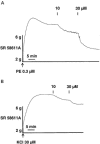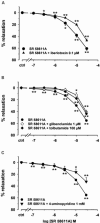Beta 3-adrenoceptor in rat aorta: molecular and biochemical characterization and signalling pathway
- PMID: 12208771
- PMCID: PMC1573490
- DOI: 10.1038/sj.bjp.0704867
Beta 3-adrenoceptor in rat aorta: molecular and biochemical characterization and signalling pathway
Abstract
1. We have previously demonstrated that beta(3)-adrenoceptor (beta(3)-AR) stimulation induces endothelium-dependent vasorelaxation in rat aorta through the activation of an endothelial NO synthase associated with an increase in intracellular cGMP. The aim of the present study was to localise beta(3)-AR to confirm our functional study and to complete the signalling pathway of beta(3)-AR in rat aorta. 2. By RT-PCR, we have detected beta(3)-AR transcripts both in aorta and in freshly isolated endothelial cells. The absence of markers for adipsin or hormone-sensitive lipase in endothelial cells excluded the presence of beta(3)-AR from adipocytes. The localization of beta(3)-AR in aortic endothelial cells was confirmed by immunohistochemistry using a rat beta(3)-AR antibody. 3. To identify the G protein linked to beta(3)-AR, experiments were performed in rat pre-treated with PTX (10 microg kg(-1)), a G(i/0) protein inhibitor. The blockage of G(i/0) protein by PTX was confirmed by the reduction of vasorelaxation induced by UK 14304, a selective alpha(2)-AR agonist. The cumulative concentration-response curve for SR 58611A, a beta(3)-AR agonist, was not significantly modified on aorta rings from PTX pre-treated rats. 4. At the same level of contraction, the relaxations induced by 10 microM SR 58611A were significantly reduced in 30 mM-KCl pre-constricted rings (E(max)=16.7+/-8.4%, n=5), in comparison to phenylephrine (0.3 microM) pre-constricted rings (E(max)=49.11+/-11.0%, n=5, P<0.05). In addition, iberotoxin (0.1 microM), glibenclamide (1 microM) and 4-aminopyridine (1 mM), selective potassium channels blockers of K(Ca), K(ATP), and K(v) respectively, decreased the SR 58611A-mediated relaxation. 5. We conclude that beta(3)-AR is preferentially expressed in rat aortic endothelial cells. Beta(3)-AR-mediated aortic relaxation is independent of G(i/0) proteins stimulation, but results from the activation of several potassium channels, K(Ca), K(ATP), and K(v).
Figures






Similar articles
-
[Vascular beta-adrenergic remodeling in rat transgenic model over-expressing endothelial beta3-adrenoceptors].Arch Mal Coeur Vaiss. 2005 Jul-Aug;98(7-8):836-40. Arch Mal Coeur Vaiss. 2005. PMID: 16220757 French.
-
[Alteration in relaxation of atypical beta-adrenergic but not beta-3 receptors in arterial hypertension in the rat].Arch Mal Coeur Vaiss. 2002 Jul-Aug;95(7-8):647-50. Arch Mal Coeur Vaiss. 2002. PMID: 12365073 French.
-
Vasorelaxation induced by the new nitric oxide donor cis-[Ru(Cl)(bpy)(2)(NO)](PF(6)) is due to activation of K(Ca) by a cGMP-dependent pathway.Vascul Pharmacol. 2007 Aug-Sep;47(2-3):139-44. doi: 10.1016/j.vph.2007.05.003. Epub 2007 Jun 2. Vascul Pharmacol. 2007. PMID: 17602893
-
Analysis of the mechanisms underlying the vasorelaxant action of kaurenoic acid in the isolated rat aorta.Eur J Pharmacol. 2004 May 25;492(2-3):233-41. doi: 10.1016/j.ejphar.2004.04.003. Eur J Pharmacol. 2004. PMID: 15178370
-
SR 58611A: SR 58611.Drugs R D. 2003;4(6):380-2. doi: 10.2165/00126839-200304060-00012. Drugs R D. 2003. PMID: 14584972 Review.
Cited by
-
β(3) Receptors: Role in Cardiometabolic Disorders.Ther Adv Endocrinol Metab. 2011 Apr;2(2):65-79. doi: 10.1177/2042018810390259. Ther Adv Endocrinol Metab. 2011. PMID: 23148172 Free PMC article.
-
beta-adrenoceptor mediated responses in rat pulmonary artery: putative role of TASK-1 related K channels.Naunyn Schmiedebergs Arch Pharmacol. 2006 Jun;373(3):186-96. doi: 10.1007/s00210-006-0060-7. Epub 2006 Apr 25. Naunyn Schmiedebergs Arch Pharmacol. 2006. PMID: 16736155
-
Atypical beta-adrenoceptors, different from beta 3-adrenoceptors and probably from the low-affinity state of beta 1-adrenoceptors, relax the rat isolated mesenteric artery.Br J Pharmacol. 2003 Sep;140(1):3-12. doi: 10.1038/sj.bjp.0705421. Epub 2003 Aug 4. Br J Pharmacol. 2003. PMID: 12967929 Free PMC article.
-
Cardiac β3 -adrenoceptors-A role in human pathophysiology?Br J Pharmacol. 2019 Jul;176(14):2482-2495. doi: 10.1111/bph.14635. Epub 2019 Apr 22. Br J Pharmacol. 2019. PMID: 30801686 Free PMC article. Review.
-
Autonomic Receptors and Nitric-Oxide Involvements in Mediating Vasorelaxation Effect Induced by Syzygium polyanthum Leaves Extract.Pharmacognosy Res. 2017 Dec;9(Suppl 1):S9-S14. doi: 10.4103/pr.pr_69_17. Pharmacognosy Res. 2017. PMID: 29333036 Free PMC article.
References
-
- ANTHONY A., SCHEPELMANN S., GUILLAUME J.L., STROSBERG A.D., DHILLON A.P., POUNDER R.E., WAKEFIELD A.J. Localization of the beta(beta)3-adrenoceptor in the human gastrointestinal tract: an immunohistochemical study. Aliment. Pharmacol. Ther. 1998;12:519–525. - PubMed
-
- BATTLE T., ARNAL J.F., CHALLAH M., MICHEL J.B. Selective isolation of rat aortic wall layers and their cell types in culture-application to converting enzyme activity measurement. Tissue Cell. 1994;26:943–955. - PubMed
-
- BITTENCOURT J.C., PRESSE F., ARIAS C., PETO C., VAUGHAN J., NAHON J.L., VALE W., SAWCHENKO P.E. The melanin-concentrating hormone system of the rat brain: an immuno- and hybridization histochemical characterization. J. Comp. Neurol. 1992;319:218–245. - PubMed
-
- CHOMCZYNSKI P., SACCHI N. Single-step method of RNA isolation by acid guanidinium thiocyanate- phenol-chloroform extraction. Anal. Biochem. 1987;162:156–159. - PubMed
-
- COOK K.S., MIN H.Y., JOHNSON D., CHAPLINSKY R.J., FLIER J.S., HUNT C.R., SPIEGELMAN B.M. Adipsin: a circulating serine protease homolog secreted by adipose tissue and sciatic nerve. Science. 1987;237:402–405. - PubMed
Publication types
MeSH terms
Substances
LinkOut - more resources
Full Text Sources
Research Materials

